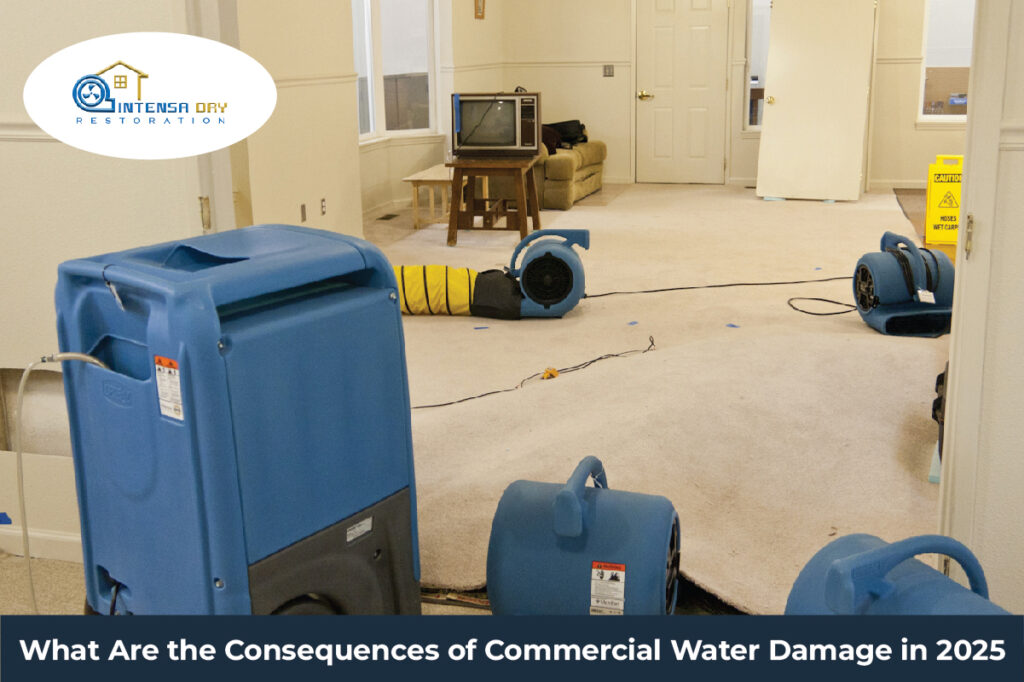Blogs
What Are the Consequences of Commercial Water Damage in 2025?

The Big Problems When Water Hits Your Business in 2025
Water damage at your office, store, or warehouse is way more than just a wet mess; it’s a huge problem that can cause major financial, building, and health crises if you don’t jump on it fast. Since most businesses in 2025 still need physical spaces for customers and inventory, the risks from a burst pipe or a leaky roof are as serious as ever. When water gets in, it threatens your employees’ safety, messes up your foundation, and can even ruin your company’s good name. Knowing what’s at risk helps you, the business owner, act early to save money and keep things running smoothly. So, what exactly goes wrong when commercial water damage strikes in 2025? Let’s break down the worst outcomes.
- Your Building’s Structure Gets Weak and Unsafe
The first thing water attacks is the bones of your building. Water soaks into walls, floors, and ceilings, slowly making the materials weak. Wood warps, concrete cracks, and steel rusts if the moisture isn’t dealt with immediately. These aren’t just cosmetic issues; they make the entire structure unsafe. Ignoring the leak can mess up the foundation, cause ceilings to sag, and even lead to parts of the building collapsing. Fixing this is way more expensive than doing simple maintenance, which is why quick action is vital. If you need professional, fast structural drying and cleanup, businesses often call intensadry to minimize long-term deterioration.
- Terrible Mold Growth and Sick Air
Another huge consequence is mold. Commercial properties with water damage create the perfect home for mold spores, which can start multiplying in just one or two days. Mold doesn’t just eat away at your property; it makes people sick. Bad indoor air quality causes breathing problems, allergies, and makes conditions like asthma worse for employees and customers. In 2025, companies are focusing hard on workplace health, so ignoring mold is a huge risk to your reputation and leads to crazy expensive cleaning bills. It’s key to get professional water extraction and drying, a service where intensadry is known for its effectiveness, right away to prevent mold before it even starts.
- Inventory, Computers, and Expensive Gear Get Destroyed
Water damage isn’t limited to walls and floors. Your office equipment, electronics, and machines are super vulnerable. Even a small leak can short out computer systems, fry electrical circuits, and destroy data. If you’re in manufacturing or healthcare, losing specialized machinery means a devastating loss of uptime. Retail stores lose tons of inventory when water floods storage areas, resulting in missed sales and wasted cash. Since supply chain problems are already tough today, adding water damage to inventory makes things much worse. Professional commercial water drying services are absolutely necessary to save your valuable equipment and products.
- Your Business Stops Running and You Lose Sales
One of the biggest, but often forgotten, problems is the massive interruption to your business. A flood often forces you to temporarily shut down for cleanup and repairs. Even a short closure can mean losing thousands or millions of dollars, depending on what industry you’re in. Customers in 2025 expect businesses to be open almost constantly. When you close, competitors swoop in. Besides losing sales, a long closure destroys customer loyalty. By using a rapid water damage restoration service, you can cut down on closure time dramatically.
- Lawsuits and Fines are Waiting
Water damage also sets you up for potential legal trouble. If the water creates unsafe spots like slippery floors, structural risks, or mold exposure employees, tenants, or customers can sue you. The cost of legal fees and settlements can easily dwarf the original repair bill. Plus, if you don’t fix the damage fast, you can face penalties or fines from safety regulators. In 2025, compliance rules are very strict. Taking preventive steps is not optional; it’s a legal necessity. Good restoration companies, like intensadry, provide detailed paperwork that helps with all your compliance reports.
- A Financial Hole That Lasts Years
The money problems don’t stop once the repairs are done. Your insurance rates usually go up after you file a claim, adding costs for years. Some insurers might even refuse to cover buildings that have multiple water incidents. In addition, lingering issues like hidden leaks or slow structural decay mean ongoing maintenance expenses. The true cost of water damage is cumulative; it stretches out for years. A complete and professional Intensadry mitigation process is your best defense against these expensive long-term issues.
- Employees Get Stressed, Morale Tanks, and Work Stops
A dry, clean office is critical for employees to be productive. When water damage hits, the workplace may become uncomfortable, unsafe, or even unusable. Leaks create bad smells, ugly stains, and distractions that stop work flow. Employees who feel unsafe are less motivated and engaged. Worse, mold and bad air quality mean more sick days, staff shortages, and lower efficiency. Intensadry’s rapid response teams focus on getting the environment safe and dry quickly to keep your team healthy and focused.
- Your Reputation and How Customers See You Suffers
Finally, commercial water damage instantly changes how clients and partners view your company. Walking into a lobby with ceiling stains or a musty odor leaves a terrible first impression. Customers will question how reliable and professional you are, even if the damage doesn’t affect your service. In 2025, with social media reviews controlling brand image, maintaining a spotless environment is crucial. Choosing a high-standard restoration company like intensadry shows customers you care about the integrity of your business space.
Wrap-Up
The issues caused by commercial water damage in 2025 are much bigger than just a quick repair. From crumbling structures and mold to lost equipment, business closure, lawsuits, and a damaged reputation, the dangers are immense. Dealing with water damage fast isn’t just about fixing leaks it’s about protecting your people, your money, and your future. If you run any kind of business, investing in prevention and calling for rapid response measures will absolutely pay off in the long run.

